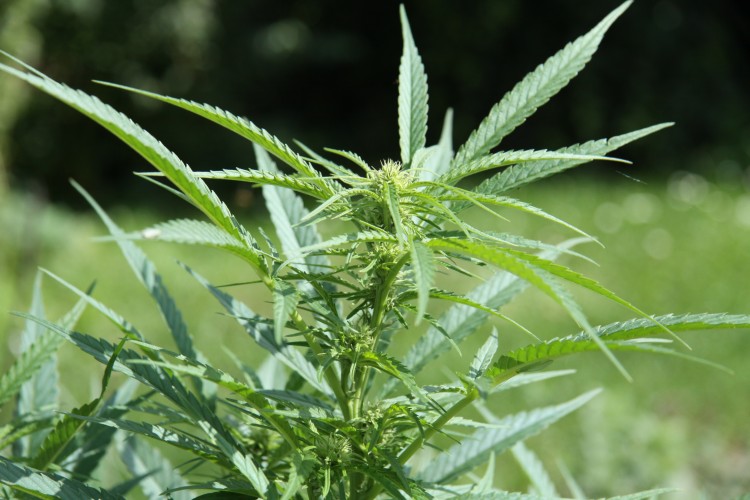U.S. Policy Keeps Medical Marijuana Research Funding Low

Certain chemicals in marijuana may kill cancer cells, shrink tumors and prevent the formation of blood vessels that feed tumors.
That’s the National Cancer Institute reporting findings from preclinical trials — the kind of research that typically leads to more in-depth testing.
But nearly a half-century ago the folks who write the checks for the cancer institute — the U.S. government — proclaimed marijuana a stoner-only drug and stamped it Schedule I, lumping it with heroin and LSD. That early war-on-drugs salvo cut the world’s biggest funder out of medical marijuana research.
Had the U.S. cut checks back then to turn the big research labs loose we might know by now that marijuana is nothing more than a good buzz, as promising as the smoke that spills out of Jeff Spicoli’s van.
Or, who knows? Marijuana-based drugs could be improving lives today. Maybe even saving some.
Because while America was just saying no, research — much of it from other countries — has shown that marijuana derivatives called cannabinoids and cannabidiol can trigger the body’s natural defenses to fight things such as cancer, Alzheimer’s, multiple sclerosis, diabetes, Crohn’s disease and epilepsy.
A Canadian study concluded cannabis reduced pain and improved sleep for sufferers of neuropathic pain. NFL Commissioner Roger Goodell announced the league is monitoring research being done in Israel on marijuana being used to treat traumatic brain injury.
Health organizations, such as the American Cancer Society, increasingly say the Schedule I label stands in the way of scientific research.
But the federal government continues to stick to its Nixon-era stance — even when calls for change come from its own agencies.
“That’s my definition of chaos,” said J. Michael Bostwick, a psychiatrist at the Mayo Clinic in Rochester, Minn., and author of “Blurred Boundaries: The Therapeutics and Politics of Medical Marijuana.”
“The federal government needs to change its position so this research can take place,” Bostwick said.
So it’s a catch-22: marijuana being on the Schedule I list impedes research that could show it doesn’t belong there.
Who can change this? That’s another fight.
Earlier this year, then-U.S. Attorney General Eric Holder called on Congress to do it. Rep. Steve Cohen, a Tennessee Democrat, quickly reminded Holder that the attorney general already had the authority to reclassify marijuana.
The easiest route would be for the Drug Enforcement Administration to act. But in 2011, the agency rejected a petition, filed nearly a decade before, to do so after hearing opposition from the Department of Health and Human Services.
It appears now that change could come from Congress, where bills have been introduced in both the House and Senate.
In March, Sen. Rand Paul of Kentucky, a Republican presidential candidate with a libertarian bent, joined Democratic Sens. Kirsten Gillibrand of New York and Corey Booker of New Jersey in introducing legislation that would change marijuana to a Schedule II drug. That would mean the federal government recognizes its medical value but that the drug can be abused, much like prescription opiates.
The 23 states that have approved medical marijuana would also be protected from federal intervention. The Obama Administration has made it clear that it would let those states play by their own rules. But his successor is not obligated to do likewise.
More states could soon join the 23 — even deep-red places like Kansas and Missouri are taking a look. Pot bills went further in Kansas this year than they ever have. Missouri last year passed a Republican-pushed bill legalizing a low-THC cannabidiol for treatment of severe epileptic seizures.
There’s still plenty of opposition. Opponents typically argue that conventional drugs are safer and that “medical marijuana” is simply an incremental ploy to get recreational pot. Indeed, in California and elsewhere it’s become common for doctors to set up shop in or next to dispensaries specifically to diagnose dubious conditions like pain from old high school football injuries.
“You’re not seeing a lot of medical support for marijuana and these state legislatures are giving pot a free rein,” said Eric Voth, a Topeka physician and longtime marijuana opponent who heads the Institute on Global Drug Policy and speaks on behalf of the national Drug Free America.
A common volley from advocates is that doctors who oppose marijuana research are probably trying to protect the prescription drug business.
But if the government should loosen its grip, Mahmoud A. ElSohly would instantly become the country’s best-known pot farmer.
He’s got 12 acres up and growing in the middle of campus at the University of Mississippi in Oxford, where the spring has been warm and rainy. A scientist and professor, ElSohly heads the federal government’s marijuana patch.
His crop is where any research project approved by the U.S. Food and Drug Administration would get its plants.
An Overland Park man with ALS, or Lou Gehrig’s Diesease, said legalization of marijuana for medical purposes is long overdue. He’s 55, father of five and grandfather of six, and uses marijuana to help with pain and spasticity. He splits his time at a second home in Colorado where marijuana is legal.
“I used to take 30 to 50 pills a day — OxyContin, oxycodone, hydrocodone,” said the man, who asked that his name not be used. “Now I’m down to zero and not zoned-out on opiates all the time.”
Cannabis chemistry
So these cannabinoids and cannabidiol (CBD) — what do they do?
Scientists say humans have a unique communication system in the brain. When receptors are triggered by cannabinoids, they transmit signals throughout the body. This “endocannabinoid system” provides the infrastructure for marijuana’s effect on humans
Sometimes that’s simply the euphoric feeling of getting high. But researchers increasingly find that those chemical charges may go through the body and kill cancer cells, ease neuropathic pain, calm seizures from epilepsy, help control blood sugar, relieve glaucoma’s intraocular pressure and perform a host of other benefits.
All this has changed minds — perhaps most famously Sanjay Gupta, CNN’s chief medical correspondent and a neurosurgeon. For years an opponent of medical marijuana, Gupta in August of 2013 apologized for misleading the country.
“We have been terribly and systematically misled for nearly 70 years in the United States, and I apologize for my own role in that,” he said.
The new information has also led to a changed political climate in which polls now show most Americans favoring legalization of marijuana.
The findings prompt even longtime marijuana opponents to acknowledge their promise. Voth says that something called “Charlotte’s Web,” a cannabidiol with little of the buzz component of marijuana, appears to be effective in treating children with epilepsy.
But he and others reject many other claims about marijuana.
In December, Samuel T. Wilkinson at Yale University’s School of Medicine released a study that showed treatment of PTSD suffered when patients smoke marijuana, although some patients swear by it. Wilkinson previously released a paper that linked marijuana use to schizophrenia.
And while the American Glaucoma Society says that marijuana eases intraocular pressure, the relief lasts only three hours. So patients need to smoke several times a day. The society advises against marijuana use as a treatment.
Hard to imagine the FDA would ever approve “crude marijuana” — joints and bong hits that put smoke in the lungs. But derivatives can come in many smokeless forms where the components and dosages can be better controlled.
That said, many patients would say don’t cut short the healing power of a good doobie.
Here’s a summary of other research:
Multiple sclerosis
The Multiple Sclerosis Society says studies suggest that a marijuana extract, usually administered in a spray beneath the tongue, may lessen symptoms of spasticity, pain related to spasticity and frequent urination.
But a clinical trial in Great Britain provided unclear results. An instrument used to measure spasticity showed little improvement even as participants reported, anecdotally, improved spasticity and less pain.
“In other words,” the study said, “participants reported feeling improvements that could not be confirmed by the study physicians.”
John Zajicek, a professor at Plymouth University Peninsula Schools of Medicine and Dentistry, led a study to evaluate oral cannabis extract in treating 400 patients. Results showed stiffness lessened by twofold in the group taking the marijuana compared to the placebo.
Improvements were also noted in body pain, spasms and sleep quality.
The American Academy of Neurology recognizes the potential, but does not support legalization of marijuana treatment.
Epilepsy
There’s been a migration of parents to treating their children with marijuana. The poster child for this movement was Charlotte Figi, a toddler who suffered Dravet Syndrome, a genetic disorder that can cause epilepsy.
“If I were Charlotte Figi’s parents and lived in Colorado, I would have done exactly what they did,” Orrin Devinsky, a professor of neurology and neurosurgery, and director of the Comprehensive Epilepsy Center at New York University, says on the Epilepsy Foundation’s website.
In 2013, researchers in the neurology department at Stanford University released a survey of 19 parents who opted for cannabis to treat a child’s seizures. These parents, on average, had previously tried 12 approved anti-epileptic drugs with little or no satisfaction.
Sixteen, or 84 percent, reported reduction in their childen’s seizure frequency while taking CBD. Two said their child became seizure-free with eight reporting a greater than 80 percent improvement.
“Parents,” researchers wrote, “report a high rate of success in reducing seizure frequency with this treatment. We can not verify the doses or the children’s response to cannabis. Nonetheless, the overall positive results on seizure control suggest that further studies are warranted.”
Cancer
The National Cancer Institute says preclinical trials on mice suggest cannabinoids may inhibit tumor growth and block the development of blood vessels that feed tumors.
Studies also show that cannabinoids may protect against inflammation of the colon and may reduce the risk of colon cancer. Another study, on mice, showed that a compound called delta-9-THC killed the cells in liver cancer and may have the same effect on lung cancer and breast cancer cells.
A laboratory study of cannabidiol in estrogen cells showed that it caused cancer cell death while leaving normal cells alone.
Despite advances in pharmacology, vomiting and nausea associated with chemotherapy remain a distressing part of cancer treatment. Trials show that patients experience less of those effects with marijuana derivatives and smoked marijuana.
Still, the cancer institute and the American Cancer Society say more proof is needed before they recommend marijuana.
Crohn’s disease
A prospective trial at Meir Medical Center in Israel showed complete remission in five of 11 patients suffering Crohn’s disease who were given cannabis twice daily.
Authors of the study said it had been reported for years that marijuana lessened painful symptoms of the inflammatory bowel disease, but the finding had not been proven in a controlled trial.
The study compared 21 patients who did not respond to conventional treatment. Half were given marijuana cigarettes. The other half were given a placebo — marijuana cigarettes with the THC removed.
The results, published in Clinical Gastroenterology and Hepatology, showed improvement in the cannabis group. Those subjects also reported improved sleep and appetite.
Alzheimer’s disease
In findings published in the Journal of Alzheimer’s Disease, researchers at the University of South Florida say delta-9 THC may prevent the abnormal production of amyloid beta, the culprit found in most aging brains that may cause the disease.
“Also, the low concentrations of THC enhance mitrochondrial function, which is needed to supply energy to a healthy brain,” said Chuanhai Cao, a neuroscientist at the Byrd Alzheimer’s Institute and USF’s college of pharmacy.
“This shows great potential.”
Old cure
To all of this, William Brook O’Shaughnessy might say, “Well, yeah.”
O’Shaughnessy, born in 1809, was an Irish physician famous for his early work in India using cannabis to treat rheumatism, infant convulsions and chronic pain. He is widely considered the man who introduced marijuana into modern medicine.
Who knows, without him, two cannabinoids — dronabinol and nabilone — approved by the FDA may not be in use today.
Advocates are pushing for more and they are not buying the argument that marijuana can be dangerous and abused. Look at the prescription opiates, such as OxyContin, that are not only addictive but blamed for many deaths, they say.
Ethan Nadelmann, executive director of the Drug Policy Alliance, said the argument against marijuana as medicine is a combination of politics and business — “It’s not a medicine if it’s not made by pharmaceutical companies or approved by the FDA.”
As for his organization’s work, he said: “We’re not doing this because we’re pro-marijuana. We are pro-responsible drug policy.”
At this point, even Eric Voth thinks change is coming.
“There is tremendous pressure out there for medical marijuana,” Voth said. “So no, I won’t be surprised when it happens.”
Article by: Donald Bradley
Source: KansasCity.com





No Comment